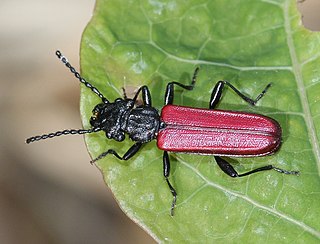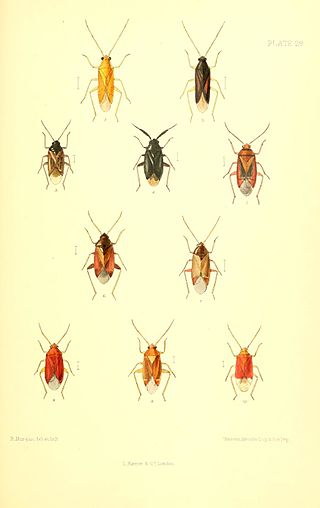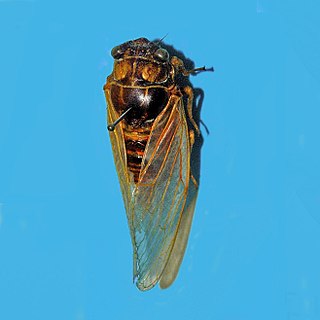
The Cucujidae, "flat bark beetles," are a family of distinctively flat beetles found worldwide under the bark of dead trees. The family has received considerable taxonomic attention in recent years and now consists of 70 species distributed in five genera. It was indicated Cucujus species are scavengers, only feeding on pupae and larvae of other insects and on other subcortical beetles such as their own. Since the Cucujidae prey on larvae of potentially tree damaging beetles that spread fungal diseases, they are considered to be beneficial to the health of living trees.

Diplacodes is a genus of dragonflies in the Libellulidae family. They are commonly known as perchers. Their colours range from the totally black body of the African Diplacodes lefebvrii, the lovely pale blue of India's Diplacodes trivialis, to the intense red of the Asian–Australian Diplacodes haematodes.

Diplacodes haematodes, the scarlet percher, is a species of dragonfly in the family Libellulidae. It occurs throughout Australia, Timor, New Guinea, Vanuatu, and New Caledonia. It is locally common in habitats with hot sunny exposed sites at or near rivers, streams, ponds, and lakes. It often prefers to settle on hot rocks rather than twigs or leaves, and is quite wary. This is a spectacular species of dragonfly, although small in size. The male is brilliant red, the female yellow-ochre. Females have yellow infuscation suffusing the outer wings, while the males have similar colour at the bases of the wings.

Salvia pratensis, the meadow clary or meadow sage, is a species of flowering plant in the family Lamiaceae, native to Europe, western Asia and northern Africa. The Latin specific epithet pratensis means "of meadows", referring to its preferred habitat. It also grows in scrub edges and woodland borders.

Cucujus is a genus of beetles in the family Cucujidae, the flat bark beetles. It contains 19 currently recognized species and subspecies.

Amyema is a genus of semi-parasitic shrubs (mistletoes) which occur in Malesia and Australia.

Pygarctia is a genus of moths in the family Erebidae.

Scolia dubia, also known as the two-spotted scoliid wasp or a blue-winged scoliid wasp, is a species in the family Scoliidae.
Anthene flavomaculatus, the yellow-spot ciliate blue, is a butterfly in the family Lycaenidae. It is found in Nigeria, Cameroon and northern Angola. The habitat consist of forests.

Rhododendron haematodes (似血杜鹃) is a rhododendron species native to northeastern Myanmar, and southeastern Xizang and western Yunnan in China, where it grows at altitudes of 3,100–4,000 m (10,200–13,100 ft). It is a dwarf evergreen shrub that grows to 0.6–1.8 m (2.0–5.9 ft) in height, with leathery leaves that are oblong to obovate, 2.7–7.5 by 0.7–3.2 cm in size. The flowers are red.
Eois haematodes is a moth in the family Geometridae. It is found in Peru.
Epiphyas haematodes is a species of moth of the family Tortricidae. It is found in Australia, where it has been recorded from New South Wales.

Tibicen is a historical genus name in the insect family Cicadidae that was originally published by P. A. Latreille in 1825 and formally made available in a translation by A. A. Berthold in 1827. The name was placed on the Official Index of Rejected and Invalid Generic Names in Zoology by the International Commission on Zoological Nomenclature in 2021. Certain European cicada species that were included by some authors in this genus at the time of its suppression are now listed under genus Lyristes Horváth, 1926. Other formerly-Tibicen species are placed in the tribe Cryptotympanini and include the genera Auritibicen Lee, 2015, Hadoa Moulds, 2015 Megatibicen Sanborn and Heath, 2016, and Neotibicen Hill and Moulds, 2015.

Aporocera is a genus of leaf beetles commonly called case bearing leaf beetles in the subfamily Cryptocephalinae. Aporocera are well represented in all states of Australia and consist of 148 species in two subspecies.

Psallus haematodes is a species of true bug. It is primarily distributed in the Palearctic region, occurring extensively throughout Europe, but its presence is limited to the northern parts of the Mediterranean. Its range extends to Siberia and the Caspian region in the east. The species has also been introduced in North America. Psallus haematodes is typically found in various habitats, including open and sunny areas, as well as shady places near wetland edges, rivers, bogs, and even dry environments.

Tibicina is a genus of cicadas belonging to the family Cicadidae, subfamily Tibicininae.

Pycnomerus is a genus of ironclad beetles in the family Zopheridae. There are more than 20 described species in Pycnomerus.
Pachybrachis haematodes, the bloody pachy, is a species of case-bearing leaf beetle in the family Chrysomelidae. It is found in Central America and North America.
Pycnomerus haematodes is a species of ironclad beetle in the family Zopheridae. It is found in North America.
Salvia haematodes can refer to:













